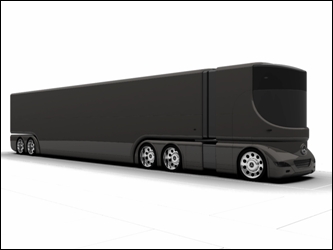The HST

The HST is an innovative truck (tractor/semi-trailer) designed for the future (2030) long-distance haulage segment in developed markets. Its aim is to present haulage firms with a maximum productivity solution - and with ever-increasing competitive pressures, maximum productivity is certainly an attractive proposition.
Driver Productivity
Since both the driving environment and experience affect the overall productivity of the driver, they are critical elements in the quest for maximum productivity. Therefore, the HST aims to present the ultimate driving environment and experience. (See below)
Vehicle Productivity
In essence, vehicle productivity is achieved by reducing costs while increasing revenue.
Costs
Undeniably, the foremost cost facing any haulage firm is fuel. Fuel consumption can be reduced with a low coefficient of drag. Therefore, for minimal air resistance, the HST aims to incorporate a sleek aerodynamic profile via a conical front, slippery body panels, flush body (i.e. no protrusions like mirrors, wipers, etc), low ride height, and panelling of the entire vehicle.
Furthermore, the undercarriage would be covered and there would be no gap between the tractor and the semi-trailer. These measures would allow the airstreams (from the front) to flow smoothly along the sides, roof, and underbody.
For an even further reduction in fuel consumption, the HST aims to incorporate a fuel-efficient driveline. (See below)
Revenue
An increase in payload would definitely result in an increase in revenue. One way to increase payload is via longer semi-trailers. However, legislation restricts the length of trucks. Reason being, longer trucks would be difficult to manoeuvre, thus risking the safety of other road users while requiring the rebuilding of infrastructure to accommodate larger turning radii. The HST aims to be longer than current trucks, but more manoeuvrable. (See below)
Superior manoeuvrability could pave the way for the legalization of longer trucks. For instance, European legislation could allow the overall length of trucks (articulated) to be increased from 16.50m to perhaps 19.50m, whereas North American legislation could allow the length of semi-trailers to be increased from 53’ to perhaps 60’.
Please download the “Overview” for more information.